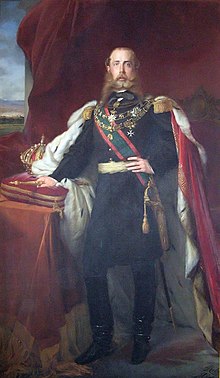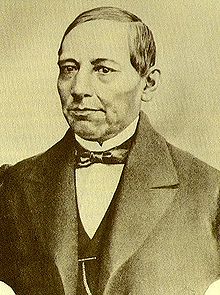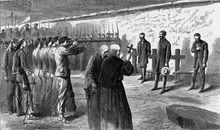Second French intervention in Mexico: Difference between revisions
cat added |
|||
| Line 65: | Line 65: | ||
==1866: French withdrawal and republican victories== |
==1866: French withdrawal and republican victories== |
||
In 1866, Napoleon III announced the withdrawal of French forces beginning [[31 May]]. The Republicans won a series of victories, occupying [[Chihuahua, Chihuahua|Chihuahua]] on [[25 March]], taking [[Guadalajara, Jalisco|Guadalajara]] on [[8 July]], further capturing Matamoros, Tampico and Acapulco in July. Napoleon III urged Maximilian |
In 1866, Napoleon III announced the withdrawal of French forces beginning [[31 May]]. The Republicans won a series of victories, occupying [[Chihuahua, Chihuahua|Chihuahua]] on [[25 March]], taking [[Guadalajara, Jalisco|Guadalajara]] on [[8 July]], further capturing Matamoros, Tampico and Acapulco in July. Napoleon III urged Maximilian to abandon Mexico. The French evacuated [[Monterrey]] on [[26 July]], [[Saltillo]] on [[5 August]], and the whole state of Sonora in September. Maximilian's French cabinet members resigned on [[18 September]]. The Republicans defeated imperial troops at [[Miahuatlán]] in [[Oaxaca]] in October, occupying the whole of Oaxaca in November, as well as parts of Zacatecas, San Luis Potosí and Guanajuato. On [[6 December]] the Austrian and Belgian volunteers disbanded and were supposed to join the Mexican Army; however, 3500 of the 4648 volunteers did not enlist, and tried to leave the country. |
||
On November 13, [[Ramón Corona]] and the French agreed to terms for the liberation of Mazatlan. At noon the invaders boarded three men-of-war, |
On November 13, [[Ramón Corona]] and the French agreed to terms for the liberation of Mazatlan. At noon the invaders boarded three men-of-war, |
||
Revision as of 21:47, 9 March 2008
| Franco-Mexican War | |||||||
|---|---|---|---|---|---|---|---|
 Battle of Puebla | |||||||
| |||||||
| Belligerents | |||||||
|
|
| ||||||
| Strength | |||||||
|
38,493 French soldiers, 7,000 Austro-Hungarian volunteers, 2,000 Belgian volunteers | ~80,000 | ||||||
| Casualties and losses | |||||||
| 6,654 French killed and wounded | 12,000 Mexican killed and wounded | ||||||



The French intervention in Mexico, also known as the Maximilian Affair, was an invasion of Mexico by the army of the Second French Empire, supported in the beginning by the British and Spanish. It followed President Benito Juárez's suspension of interest payments to foreign countries on 17 July 1861, which angered Spain, France, and Britain. Napoleon III of France was the leader of this operation, and the three powers signed the Treaty of London on 31 October, to unite their efforts to receive payments from Mexico. On 8 December the Spanish fleet and troops from Spanish-controlled Cuba arrived at Mexico's main Gulf port, Veracruz.
The presidential terms of Benito Juárez (1858–71) were interrupted by the Habsburg monarchy's rule of Mexico (1864–67). Conservatives tried to institute a monarchy when they helped to bring to Mexico an archduke from the Royal House of Austria, Maximilian of Habsburg (who married Charlotte of Belgium, also known as Carlota of Mexico), with the military support of France, which was interested in exploiting the rich mines in the north-west of the country. Many historians believe that the French established the monarchy when they did due to the fact that the United States was in the middle of its Civil War (1861–65), and thus was unable to intervene (as it would likely have done according to its Monroe Doctrine.)
1862: The French Arrive
The British and French fleets arrived at Veracruz, between 6 January and 8 January 1862. The city of Campeche surrendered to the French fleet on 27 February, and a French army, commanded by General Lorencez, arrived on 5 March. When the Spanish and British realised the French ambition to conquer Mexico, they withdrew their forces on 9 April, their troops leaving on 24 April. In May, the French man-of-war La Bayonnaise blockaded Mazatlán for a few days.
Although the French army, then considered the most efficient in the world, suffered an initial defeat in the Battle of Puebla on 5 May 1862 (now the Cinco de Mayo commemoration day) they eventually defeated the Mexican government forces commanded by general Ignacio Zaragoza. The pursuing Mexican army was contained by the French at Orizaba, Veracruz, on 14 June. More French troops arrived on 21 September, and General Bazaine arrived with more reinforcements on 16 October. Tampico, Tamaulipas, was occupied by the army of France on 23 October, with Xalapa, Veracruz, taken peacefully on 12 December.
1863: French take the capital
The French bombarded Veracruz on 15 January 1863. Then, on 16 March, General Forey and the French army began the siege of Puebla.
On 30 April, the French Foreign Legion earned its legendary status in the Battle of Camarón when the small infantry patrol unit led by Capitaine Danjou numbering 62 soldiers and three officers was attacked and besieged by Mexican infantry and cavalry units numbering three battalions, and was forced to make a defense in Hacienda Camarón. Danjou was mortally wounded in the defense of the hacienda, and the last of his men mounted a desperate bayonet attack. They fought to nearly the last man, with three survivors. To this day, 'Camerone Day' is still the most important day of celebration for Legionnaires.
The French army of General Bazaine defeated the Mexican army led by General Comonfort in their attempt to relieve the siege of Puebla, at San Lorenzo, to the south of Puebla. Puebla surrendered to the French shortly afterward, on 17 May. On 31 May, President Juárez with his cabinet fled the city, retreating northwards to El Paso del Norte and later to Chihuahua, where the government-in-exile remained until 1867, taking the treasure of the state with them.
| History of Mexico |
|---|
 |
| Timeline |
|
|
French troops under Bazaine entered Mexico City on 7 June 1863. The main army entered the city three days later led by General Forey. General Almonte was appointed the provisional President of Mexico on 16 June, by the Superior Junta (which had been appointed by Forey) The Superior Junta with its 35 members met on 21 June, and proclaimed a Catholic Empire on 10 July. The crown was offered to Maximilian, due to Napoleon's efforts. Maximilian accepted the crown on 3 October, at his castle Miramar near Trieste, having being offered it by the Comisión Mexicana, sent by the Superior Junta.
1864: Arrival of Maximilian
On March, 28 and 31, 1864 crew men of Cordeliere, a French man-of-war, tried to take Mazatlan, but were repelled by Mexicans commanded by Colonel Gaspar Sánchez Ochoa.
The French under Bazaine occupied Guadalajara on 7 January 1864, and troops under Douay occupied Zacatecas on 6 February. Further French victories continued with the fall of Acapulco on 3 June, occupation of Durango on 3 July, and the defeat of republicans in the states of Sinaloa and Jalisco in November.
Maximilian landed at Veracruz on 28 May (or possibly 29 May) 1864 in the SMS Novara and accepted the crown formally on 10 April, signing the Treaty of Miramar. He was enthroned as Maximilian, Emperor of Mexico. Maximilian of Habsburg was very much the product of progressive ideas in vogue in the West at the time. He favored the establishment of a limited monarchy sharing powers with a democratically elected congress and inspired laws that abolished child labor, limited working hours, and abolished a system of land tenancy that virtually amounted to serfdom among the Indians. This was too liberal to please Mexico's conservatives, while the liberals refused to accept a monarch, leaving Maximilian with few enthusiastic allies within Mexico.
On Sunday, November 13, 1864, three French men-of-war (Victoire, D'Assas and Diamante) shelled Mazatlan 13 times, and Imperial Mexican forces under Manuel Lozada entered and captured the city.
1865: Beginning of republican victories
The French continued with victories in 1865, with Bazaine capturing Oaxaca on 9 February (defeating the city's defenders under General Porfirio Díaz). The French fleet landed soldiers who captured Guaymas on 29 March. However on 11 April, republicans defeated Imperial forces at Tacámbaro in Michoacán. In April and May the republicans had many forces in the states of Sinaloa and Chihuahua. Most towns along the Rio Grande were also occupied by republicans. The Belgian volunteers defeated the republicans at the Second Battle of Tacámbaro on 11 July.
The decree known as the "Black Decree" was issued by Maximilian on 3 October, which threatened any Mexican captured in the war with immediate execution. This was the later basis of his own execution. Several of the high ranking officials of the republicans were executed under this order on 21 October.
U.S. Intervention
American President Abraham Lincoln had supported the republicans under Juárez, but was unable to intervene due to the American Civil War. Immediately after the end of the war, in 1865, United States Army General Philip Sheridan, under the supervision of President Andrew Johnson and General Ulysses S. Grant, assembled 50,000 troops, and dispatched them to the border between Mexico and the United States. There, his corps ran patrols to visibly threaten intervention against the French, and also supplied arms to Juárez's forces.[1] The US Congress had unanimously passed a resolution which opposed the establishment of the Mexican monarchy on 4 April 1864. On 12 February 1866, the US demanded the French withdraw their forces from Mexico, moved soldiers to positions along the Rio Grande, and set up a naval blockade to prevent French reinforcements from landing. The US officially protested to Austria about the Austrian volunteers in Mexico on the 6th of May.
1866: French withdrawal and republican victories
In 1866, Napoleon III announced the withdrawal of French forces beginning 31 May. The Republicans won a series of victories, occupying Chihuahua on 25 March, taking Guadalajara on 8 July, further capturing Matamoros, Tampico and Acapulco in July. Napoleon III urged Maximilian to abandon Mexico. The French evacuated Monterrey on 26 July, Saltillo on 5 August, and the whole state of Sonora in September. Maximilian's French cabinet members resigned on 18 September. The Republicans defeated imperial troops at Miahuatlán in Oaxaca in October, occupying the whole of Oaxaca in November, as well as parts of Zacatecas, San Luis Potosí and Guanajuato. On 6 December the Austrian and Belgian volunteers disbanded and were supposed to join the Mexican Army; however, 3500 of the 4648 volunteers did not enlist, and tried to leave the country.
On November 13, Ramón Corona and the French agreed to terms for the liberation of Mazatlan. At noon the invaders boarded three men-of-war, Rhin, Marie and Talisman and departed.
1867: Republicans take the capital

The Republicans occupied the rest of the states of Zacatecas, San Luis Potosí and Guanajuato in January. The French evacuated the capital on 5 February.
On 13 February 1867, Maximilian withdrew to Querétaro. The Republicans began a siege of the city on 9 March, and Mexico City on 12 April. An imperial sortie from Querétaro failed on 27 April.
On 11 May Maximilian resolved to attempt an escape through the enemy lines. He was, however, intercepted before he could carry out this plan on 15 May and, following a court-martial, was sentenced to death. Many of the crowned heads of Europe and other prominent figures (including Victor Hugo and Giuseppe Garibaldi) sent telegrams and letters to Mexico pleading for Maximilian's life to be spared, but Juárez refused to commute the sentence, believing that it was necessary to send a message that Mexico would not tolerate any government imposed by foreign powers.
Maximilian was executed on 19 June (along with his generals Miguel Miramón and Tomás Mejía) on the Cerro de las Campanas, a hill on the outskirts of Querétaro, by the forces loyal to President Benito Juárez, who had kept the federal government functioning during the French intervention. Juárez's position was further strengthened when the United States deployed troops to the Rio Grande, and threatened an invasion. Mexico City surrendered the day after Maximilian was executed.
The republic was restored, President Juárez was returned to power in the national capital, and the 1857 Constitution of Mexico once again was unchallenged supreme charter of the country. Among other things, the constitution confiscated the vast landholdings of the Catholic church (which had been acting as landlord over half the country), established civil marriages, and forbade the participation of priests in politics (the separation of Church and State).
After the victory, the Conservative party was so thoroughly discredited by its alliance with the invading French troops that it effectively ceased to exist, and the Liberal party was almost unchallenged as a political force during the first years of the "restored republic." In 1871, however, Juárez was re-elected to yet another term as president in spite of a constitutional prohibition of re-elections, provoking one of the losing candidates, Porfirio Díaz (a Liberal general and a hero of the French war, but increasingly conservative in outlook) to launch a rebellion against the president. Supported by conservative factions within the Liberal party, the attempted revolt (the so-called Plan de la Noria) was already at the point of defeat when Juárez died in office on 19 July 1872, making it a moot point. Díaz ran against interim president Sebastián Lerdo de Tejada, lost the election, and retired to his hacienda in Oaxaca. Four years later, in 1876, when Lerdo himself ran for re-election, Díaz launched a second, successful revolt (the Plan de Tuxtepec) and captured the presidency, which he effectively held through eight terms until 1911.
See also
- Pastry War, an earlier invasion of Mexico by the French
- Reform War
- History of Mexico
References
- Sheridan, Philip H., Personal Memoirs of P.H. Sheridan, Charles L. Webster & Co., 1888, ISBN 1-58218-185-3 (vol. 1).
- Lerma Garay, Antonio. Mazatlán Decimonónico, Autoedición. 2005. ISBN 1-59872-220-4.
Notes
- ^ Sheridan, p. 405.
